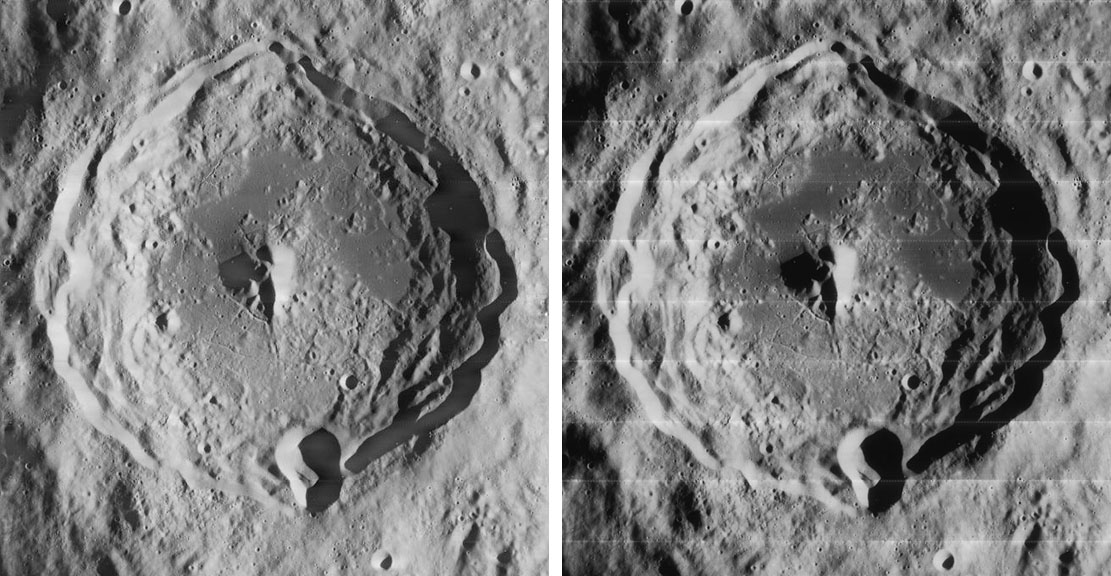|
|
| (5 intermediate revisions by the same user not shown) |
| Line 1: |
Line 1: |
| | __NOTOC__ | | __NOTOC__ |
| | =Be Gone, Obnoxious Framelet Lines!= | | =Be Gone, Obnoxious Framelet Lines!= |
| | + | <!-- Start of content --> |
| | + | <div class="post" id="post-1383"> |
| | | | |
| − |
| + | <div class="storycontent"> |
| − | <div class="post" id="post-1383">
| + | <p>[[File:Schluter-LPOD.jpg|Schluter-LPOD.jpg]]<br /> |
| − |
| |
| − | <div class="storycontent">
| |
| − | <p>[[File:Schluter-LPOD.jpg|Schluter-LPOD.jpg]]<br />
| |
| | <em>Lunar Orbiter image - original (right) and destriped (left) by [mailto:njnoordhoek@hotmail.com Niels Noordhoek]</em></p> | | <em>Lunar Orbiter image - original (right) and destriped (left) by [mailto:njnoordhoek@hotmail.com Niels Noordhoek]</em></p> |
| | <p>Frequently, high resolution Moon images are presented in LPOD that contain "framelet lines". The images are stitched together from film strips, that were chemically processed (!), scanned and transmitted to Earth from Moon-orbiting spacecraft such as the Lunar Orbiters. Though it is probably scientifically most correct to present the raw data as-is, a potentially pretty image is spoilt by the missing data between the framelets and the bands of varying brightness at their edges. The film data were finally lost, because the orbiters were purposely crashed onto the Moon’s surface to prevent possible hazard to future Apollo missions. To perform plastic surgery on the images, a filter was written in Matlab, an easy to use numerical software package, which can be used for image display and processing. The code reads in the image, low-pass filters it in a horizontal direction, and high-pass filters it again in a vertical direction. The result is an image that shows only the framelet lines and intensity modulations. The original image is divided by this image, removing most of the artefacts. A side effect is that the contrast of the image is somewhat reduced. For those who are mathematically inclined but do not want to spend money on a commercial Matlab license, free alternatives are available to run the code: [http://www.gnu.org/software/octave/ Octave], [http://www.scilab.org/ SciLab] and [http://freemat.sourceforge.net/wiki/index.php/Main_Page FreeMat].</p> | | <p>Frequently, high resolution Moon images are presented in LPOD that contain "framelet lines". The images are stitched together from film strips, that were chemically processed (!), scanned and transmitted to Earth from Moon-orbiting spacecraft such as the Lunar Orbiters. Though it is probably scientifically most correct to present the raw data as-is, a potentially pretty image is spoilt by the missing data between the framelets and the bands of varying brightness at their edges. The film data were finally lost, because the orbiters were purposely crashed onto the Moon’s surface to prevent possible hazard to future Apollo missions. To perform plastic surgery on the images, a filter was written in Matlab, an easy to use numerical software package, which can be used for image display and processing. The code reads in the image, low-pass filters it in a horizontal direction, and high-pass filters it again in a vertical direction. The result is an image that shows only the framelet lines and intensity modulations. The original image is divided by this image, removing most of the artefacts. A side effect is that the contrast of the image is somewhat reduced. For those who are mathematically inclined but do not want to spend money on a commercial Matlab license, free alternatives are available to run the code: [http://www.gnu.org/software/octave/ Octave], [http://www.scilab.org/ SciLab] and [http://freemat.sourceforge.net/wiki/index.php/Main_Page FreeMat].</p> |
| | <p align="right"><em>Niels J. Noordhoek </em></p> | | <p align="right"><em>Niels J. Noordhoek </em></p> |
| − | <p><em>Note by CAW: This is the general technique used by the [http://www.lpi.usra.edu/meetings/lpsc2007/pdf/2092.pdf US Geological Survey] to destripe all the Orbiter IV images to make a (so far unreleased) nearside mosaic, and by Charles Byrne in his </em><em>[http://www.lpod.org/?m=20060213 Lunar Orbiter Photographic Atlas of the Nearside of the Moon]</em> and his forthcoming companion farside atlas. In the mid-1970s, Tim Mutch at Brown University tried to destripe Orbiter images using the first generation tapes. Unfortunately, no tape drive could be found anywhere in the country that could read the decade old tapes and the project was abandoned. </p> | + | <p><em>Note by CAW: This is the general technique used by the [http://www.lpi.usra.edu/meetings/lpsc2007/pdf/2092.pdf US Geological Survey] to destripe all the Orbiter IV images to make a (so far unreleased) nearside mosaic, and by Charles Byrne in his </em><em>[[February_13,_2006|Lunar Orbiter Photographic Atlas of the Nearside of the Moon]]</em> and his forthcoming companion farside atlas. In the mid-1970s, Tim Mutch at Brown University tried to destripe Orbiter images using the first generation tapes. Unfortunately, no tape drive could be found anywhere in the country that could read the decade old tapes and the project was abandoned. </p> |
| | <p><strong>Technical Details:</strong><br /> | | <p><strong>Technical Details:</strong><br /> |
| − | A version of Niels’ article with more illustrations and Matlab code is [http://www.lpod.org/?page_id=1388 here]. If you don’t recognize the crater, click [http://www.lpod.org/?m=20070610 here.]</p> | + | A version of Niels’ article with more illustrations and Matlab code is [http://www.lpod.org/?page_id=1388 here]. If you don’t recognize the crater, click [[June_10,_2007|here.]]</p> |
| | <p><strong>Related Links:</strong><br /> | | <p><strong>Related Links:</strong><br /> |
| | [http://www.njnoordhoek.com Niels’ website]</p> | | [http://www.njnoordhoek.com Niels’ website]</p> |
| − | <p align="center"><em>Now you can support LPOD when you buy ANY book from Amazon thru [[LPOD]]</em></p> | + | <p><b>Yesterday's LPOD:</b> [[September 12, 2007|Rimae Fantasticus]] </p> |
| − | </div>
| + | <p><b>Tomorrow's LPOD:</b> [[September 14, 2007|A New Era of Lunar Exploration!]] </p> |
| − |
| + | <!-- Removed reference to store page 2 --> |
| − | | + | </div> |
| − | ---- | + | <!-- End of content --> |
| − | ===COMMENTS?===
| + | {{wiki/ArticleFooter}} |
| − | Click on this icon [[image:PostIcon.jpg]] at the upper right to post a comment.
| |




